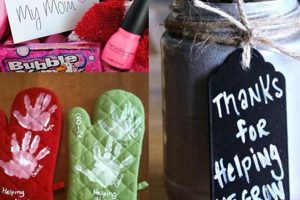The creation of personalized holiday containers for small gifts and treats, crafted by individuals rather than purchased pre-made, constitutes a seasonal activity undertaken in many households. For example, individuals might sew, knit, or felt these festive receptacles, incorporating unique designs and embellishments that reflect personal preferences or the recipient’s interests.
This practice offers several advantages, including cost savings compared to purchasing ready-made versions, the opportunity to create bespoke items with sentimental value, and the fostering of creativity and crafting skills. Historically, handmade decorations have played a significant role in holiday celebrations, providing a personal touch and reflecting cultural traditions or family heritage.
Subsequent sections will explore various techniques for constructing these handcrafted items, detailing material selection, pattern options, and decorative embellishment methods applicable to personalized seasonal gift holders.
DIY Stockings
Constructing personalized holiday gift receptacles requires careful planning and execution. The following guidelines provide a framework for achieving durable and aesthetically pleasing results.
Tip 1: Fabric Selection. Opt for durable fabrics such as felt, canvas, or cotton twill. These materials withstand wear and tear and provide a stable base for embellishments.
Tip 2: Pattern Precision. Accurate pattern tracing and cutting are crucial for achieving symmetrical and well-proportioned forms. Utilize a sharp cutting tool and a stable cutting surface.
Tip 3: Seam Reinforcement. Strengthen seams with a backstitch or multiple rows of stitching, particularly at stress points such as the heel and toe. This enhances the item’s longevity.
Tip 4: Secure Hanging Loop. Attach the hanging loop securely to the stocking’s upper corner. Reinforce the attachment point with additional stitching or interfacing to prevent tearing.
Tip 5: Lining Consideration. Incorporate a lining, especially when using loosely woven fabrics or incorporating embellishments with rough edges. This protects the contents and enhances the item’s overall finish.
Tip 6: Embellishment Adherence. Ensure embellishments are securely attached using appropriate adhesives or stitching techniques. Test the bond strength before finalizing the design.
Tip 7: Consistent Seam Allowance. Maintain a consistent seam allowance throughout the construction process. This ensures uniformity and a professional appearance.
Adhering to these guidelines will result in durable, visually appealing, and personalized holiday gift holders that can be enjoyed for years to come. Attention to detail and quality craftsmanship are paramount.
The subsequent section will offer a comprehensive exploration of design ideas and innovative embellishment strategies to further enhance the aesthetic appeal of these handcrafted creations.
1. Fabric Durability
Fabric durability is paramount in the context of handcrafted seasonal gift receptacles, directly influencing the item’s longevity and its capacity to withstand repeated use and handling. Selecting appropriate materials ensures that these festive containers can become cherished heirlooms, passed down through generations.
- Tear Resistance
Tear resistance refers to a fabric’s ability to withstand force without ripping or tearing. For seasonal gift receptacles, this is crucial, especially when filled with heavier items. Examples include using tightly woven canvas or felted wool, which offer superior tear resistance compared to loosely woven cotton. Poor tear resistance leads to premature damage and reduces the item’s usability.
- Abrasion Resistance
Abrasion resistance denotes a fabric’s capacity to withstand surface wear and friction. Gift receptacles are often subjected to rubbing against other surfaces during storage or display. Materials like denim or tightly knit fabrics exhibit excellent abrasion resistance, minimizing pilling and wear over time. In contrast, delicate fabrics such as silk or loosely woven linen are prone to abrasion damage.
- Tensile Strength
Tensile strength measures a fabric’s ability to withstand pulling or stretching forces before breaking. This is particularly relevant for the hanging loop and seams. Using fabrics with high tensile strength, such as reinforced cotton or synthetic blends, prevents the loop from tearing or the seams from splitting under the weight of gifts. Low tensile strength compromises the structural integrity of the seasonal container.
- Colorfastness
Colorfastness refers to a fabric’s resistance to fading or bleeding when exposed to light, washing, or friction. Selecting fabrics with good colorfastness ensures that the colors remain vibrant and the design remains intact over time. Fabrics treated with color-locking dyes or inherently fade-resistant materials are preferred. Poor colorfastness results in discoloration and a diminished aesthetic appeal.
The interrelationship of these facets within fabric durability contributes significantly to the overall quality and lifespan of handcrafted seasonal gift holders. By prioritizing materials with robust tear, abrasion, and tensile strength, as well as excellent colorfastness, crafters can ensure that their creations become enduring symbols of holiday tradition, rather than disposable decorations.
2. Pattern Accuracy
Pattern accuracy forms a foundational element in the successful creation of handcrafted seasonal gift receptacles. Precise pattern execution directly impacts the final product’s symmetry, proportions, and overall aesthetic appeal. Discrepancies in the pattern can lead to dimensional distortions and a compromised visual outcome.
- Dimensional Stability
Dimensional stability refers to the consistency of measurements between the intended pattern dimensions and the actual cut fabric pieces. Accurate pattern execution ensures that each component of the seasonal gift receptacle, such as the front, back, heel, and toe, adheres to the specified sizes and shapes. For example, a pattern with a precisely marked 12-inch height will yield a fabric piece that accurately measures 12 inches in height. Conversely, an inaccurate pattern may result in variations in size, leading to mismatched seams and an asymmetrical final form. The implications of poor dimensional stability include difficulty in assembly and a visually unbalanced end product.
- Symmetrical Integrity
Symmetrical integrity dictates the mirroring of design elements between the left and right sides of the seasonal gift receptacle. An accurate pattern maintains perfect symmetry, ensuring that design features such as appliqus, embroidery, or fabric patterns are evenly distributed and aligned. For example, a symmetrical pattern will position identical embellishments at equal distances from the center line of the stocking. Inaccurate patterns can lead to noticeable imbalances, where design elements are offset or distorted, detracting from the overall visual harmony. Compromised symmetrical integrity results in an unprofessional and aesthetically unappealing outcome.
- Seam Alignment
Seam alignment pertains to the precise matching of edges during the assembly process. Accurate pattern pieces facilitate effortless and accurate seam alignment, ensuring that the fabric edges meet seamlessly and without puckering or distortion. For example, a well-drafted pattern will align the curves of the heel and toe pieces perfectly, creating a smooth and even seam. Conversely, inaccurate patterns can result in misaligned edges, requiring adjustments and alterations to achieve a presentable seam. Difficulty in achieving proper seam alignment compromises the structural integrity and visual appeal of the finished seasonal gift receptacle.
- Design Feature Placement
Design feature placement involves the accurate positioning of embellishments, pockets, or other decorative elements on the seasonal gift receptacle. Accurate patterns include precise markings for placement, ensuring that these features are correctly positioned and oriented. For example, a pattern will indicate the exact location for attaching a pocket, ensuring that it is centered and level. Inaccurate patterns can lead to misplaced or misaligned design features, disrupting the overall aesthetic and functionality. Improper design feature placement detracts from the intended design and creates a haphazard appearance.
These facets of pattern accuracy underscore its critical role in producing high-quality, aesthetically pleasing seasonal gift receptacles. Attention to detail in pattern drafting and execution ensures that the final product exhibits dimensional stability, symmetrical integrity, proper seam alignment, and precise design feature placement, elevating the handcrafted item to a treasured holiday keepsake.
3. Seam Strength
Seam strength represents a critical factor in the construction of handcrafted seasonal gift receptacles. The integrity of the seams directly influences the item’s durability, longevity, and ability to withstand the weight of contained gifts. Inadequate seam strength can lead to premature failure, compromising the functional and aesthetic value of the handcrafted item.
- Stitch Density
Stitch density, measured as the number of stitches per inch (SPI), directly correlates with seam strength. A higher SPI creates a denser and more secure seam, minimizing the risk of seam slippage or breakage under stress. For instance, crafting seasonal gift receptacles from heavy-weight fabrics such as canvas or denim necessitates a higher SPI compared to lighter fabrics such as cotton or felt. An insufficient SPI can result in seams that unravel easily, particularly when the receptacle is filled with heavy or bulky items. This leads to structural failure and reduces the item’s lifespan.
- Thread Type
The type of thread employed in seam construction significantly impacts seam strength. Threads composed of strong, durable materials such as polyester or nylon offer superior resistance to abrasion, tension, and degradation compared to weaker threads such as cotton or rayon. Using a high-quality thread appropriate for the fabric type ensures that the seams can withstand the stresses associated with filling, handling, and displaying the seasonal gift receptacle. The selection of inappropriate thread, conversely, leads to weakened seams that are prone to breakage, especially under stress.
- Seam Reinforcement Techniques
Seam reinforcement techniques enhance seam strength by providing additional support and stability. Techniques such as backstitching, serging, or using a French seam create multiple layers of fabric and stitching, distributing stress and preventing seam unraveling. For example, reinforcing the heel and toe seams of a seasonal gift receptacle, which are subjected to high stress, with a backstitch ensures that these critical areas remain intact. Neglecting seam reinforcement techniques results in vulnerable seams that are susceptible to failure, particularly at high-stress points.
- Seam Allowance
Seam allowance refers to the width of fabric between the seam line and the raw edge of the fabric. An adequate seam allowance provides sufficient fabric for the stitching to grip, preventing the fabric from pulling away from the seam. For example, utilizing a wider seam allowance of 5/8 inch for heavyweight fabrics ensures that the stitching is securely anchored. Insufficient seam allowance leads to weakened seams that are prone to tearing, especially when the receptacle is filled with heavier items.
The aforementioned facets collectively contribute to the overall seam strength of handcrafted seasonal gift receptacles. Attentive consideration of stitch density, thread type, seam reinforcement techniques, and seam allowance ensures that these handcrafted items are durable, resilient, and capable of withstanding the demands of holiday use. Compromising on any of these facets jeopardizes the structural integrity and longevity of the crafted items, diminishing their value as cherished holiday keepsakes.
4. Hanging Loop Security
Hanging loop security represents a critical, often overlooked, component in the creation of handcrafted seasonal gift receptacles. The ability of the item to be securely displayed depends entirely on the integrity of this attachment point, making it paramount to the overall success and practicality of the finished product.
- Material Selection for the Loop
The choice of material for the hanging loop directly impacts its strength and longevity. Durable materials such as heavy-duty twill tape, sturdy braided cord, or reinforced ribbon are preferable to more fragile options like thin yarn or delicate ribbon. For example, a loop constructed from reinforced nylon webbing can withstand significantly more weight and stress than a loop made from thin satin ribbon. Inadequate material selection compromises the loop’s ability to support the weight of the filled gift receptacle, potentially leading to detachment and damage.
- Attachment Method
The method used to attach the hanging loop to the body of the seasonal gift receptacle profoundly affects its security. Sewing the loop directly into the seam during construction, reinforcing the attachment point with multiple rows of stitching, or incorporating interfacing to provide additional stability are effective techniques. Conversely, simply gluing the loop or using a single, weak stitch provides inadequate support. An example of robust attachment involves sandwiching the loop between the lining and outer fabric layers and securing it with a box stitch. Insufficient attachment methods result in a weak connection that is prone to tearing or detaching under the weight of gifts, rendering the receptacle unusable.
- Placement of the Loop
The placement of the hanging loop relative to the overall structure of the seasonal gift receptacle influences its stability and balance when hung. Positioning the loop at a reinforced corner or along a structural seam distributes the weight more evenly, minimizing stress on the attachment point. Conversely, attaching the loop to a weak or unsupported area of the fabric concentrates the stress, increasing the likelihood of tearing. For instance, placing the loop at the intersection of two reinforced seams provides a more secure anchor point than attaching it to a single layer of fabric. Improper loop placement can lead to uneven weight distribution and eventual failure of the attachment point.
- Reinforcement Techniques
Employing reinforcement techniques further enhances the security of the hanging loop. Adding interfacing to the fabric behind the attachment point, using multiple layers of fabric, or incorporating decorative elements that also serve as reinforcement can significantly increase its strength. An example includes adding a small, decorative button or patch over the attachment point, which both conceals the stitching and provides additional support. Neglecting reinforcement techniques leaves the attachment point vulnerable to stress and premature failure, particularly with heavier contents.
In summary, the security of the hanging loop is not merely an afterthought in the creation of handcrafted seasonal gift receptacles; it is an integral design element that demands careful consideration and execution. The selection of appropriate materials, robust attachment methods, strategic placement, and effective reinforcement techniques all contribute to a secure and reliable hanging loop, ensuring that the handcrafted item can be proudly displayed as a lasting symbol of holiday tradition.
5. Lining Implementation
The incorporation of a lining within handcrafted seasonal gift receptacles is a design consideration that significantly impacts the item’s durability, aesthetic appeal, and functional performance. Thoughtful selection and application of lining materials enhance the overall quality and longevity of these festive creations.
- Enhanced Durability and Structure
A lining provides an additional layer of fabric that reinforces the main fabric of the gift receptacle, thereby increasing its structural integrity and resistance to wear and tear. For instance, a delicate outer fabric like velvet or lace can be protected from stretching or snagging by a sturdy cotton or polyester lining. This added layer also prevents the seams from fraying and strengthens the overall construction. The absence of a lining can lead to premature damage, reducing the item’s lifespan, particularly when filled with heavier gifts.
- Concealment of Raw Edges and Seams
A lining effectively conceals raw edges and exposed seams within the gift receptacle, creating a clean and professional finish. This is particularly important when using fabrics that fray easily or when intricate embellishments are added. For example, a lining can hide the raw edges of appliqus or embroidery, preventing them from unraveling and creating a more polished appearance. Without a lining, raw edges can detract from the aesthetic appeal and contribute to a less refined final product.
- Protection of Contents
A lining serves as a protective barrier for the contents of the gift receptacle, preventing small or delicate items from snagging on rough seams or embellishments. This is especially important when gifting items such as jewelry, delicate clothing, or confectionery. For example, a smooth satin lining can prevent a necklace from getting tangled on the interior of the gift receptacle. The absence of a lining can lead to damage or loss of smaller items and compromise the presentation of the gift.
- Improved Aesthetic Appeal
The selection of a complementary lining fabric can enhance the overall aesthetic appeal of the gift receptacle. A contrasting color or pattern can add visual interest and create a more luxurious feel. For example, a red velvet outer fabric paired with a gold satin lining creates a classic and elegant look. Moreover, a lining can provide a smooth, even surface that allows the outer fabric and embellishments to shine. A poorly chosen or omitted lining can detract from the overall design and create a less visually appealing final product.
In conclusion, the implementation of a lining within handcrafted seasonal gift receptacles represents a strategic design choice that contributes significantly to the item’s durability, functionality, and aesthetic qualities. Careful consideration of lining materials and construction techniques results in a higher-quality, more visually appealing, and longer-lasting product that enhances the overall holiday experience.
6. Embellishment Adherence
Embellishment adherence directly affects the longevity and aesthetic appeal of handcrafted seasonal gift receptacles. When decorations such as sequins, beads, or appliques are improperly secured to a stocking, the result is a diminished visual presentation and a compromised structural integrity. For instance, if fabric glue fails to adequately bond felt shapes to a stocking made of quilted cotton, the shapes will detach with handling, thereby reducing the decorative effect and potentially damaging the underlying fabric. The selection of appropriate adhesives or stitching techniques, therefore, is critical to ensuring that embellishments remain securely affixed throughout the stocking’s lifespan.
The practical significance of this connection becomes evident during the cleaning or storage of the seasonal item. A stocking with poorly adhered embellishments is more susceptible to damage during washing, potentially losing its decorations or suffering fabric distortions. Similarly, when stored, loosely attached embellishments can snag on other items, leading to further detachment or damage. By contrast, stockings with securely attached embellishments can withstand the rigors of cleaning and storage, preserving their visual appeal for years. Selecting techniques like heat-activated fusing for patches or carefully sewn beadwork can enhance long-term durability.
In summary, effective embellishment adherence is not merely a superficial detail in the creation of handcrafted seasonal gift receptacles; it is an integral component that directly influences the items durability, maintainability, and enduring aesthetic value. Addressing challenges associated with fabric compatibility, adhesive selection, and application techniques is essential to ensure that these handcrafted items remain treasured holiday decorations for seasons to come, rather than becoming disposable projects.
7. Size Appropriateness
The concept of size appropriateness in the context of self-made holiday gift containers directly impacts functionality, material usage, and overall design. Optimal dimensions contribute to a practical and aesthetically balanced final product, aligning with intended gifting purposes.
- Recipient Age and Physical Size of Gifts
The age of the recipient and the physical dimensions of anticipated gifts necessitate adjustments in the seasonal container’s size. A child-oriented receptacle may require a smaller overall volume to accommodate age-appropriate toys and treats, while an adult’s may demand increased capacity for larger items such as books or clothing accessories. Ignoring this consideration results in an item that is either underutilized or unable to fulfill its intended purpose, leading to dissatisfaction and potentially necessitating the acquisition of a secondary container.
- Material Consumption and Cost Efficiency
The selected dimensions directly influence the quantity of materials required for construction, affecting overall cost efficiency. An excessively large design increases fabric consumption, thereby raising the project’s expense. Conversely, a design that is too small may necessitate the omission of intended gifts. Careful planning and accurate measurements minimize material waste and ensure that the final product is both cost-effective and functionally suitable. For example, precise calculation of fabric requirements based on desired dimensions prevents overspending and reduces environmental impact.
- Structural Integrity and Weight Distribution
Size appropriateness directly affects the structural integrity and weight distribution of the finished item. An oversized container, when filled, may place undue stress on seams and the hanging loop, increasing the risk of tearing or detachment. A smaller, more compact design enhances structural stability and distributes weight more evenly, minimizing stress on critical connection points. Reinforcement of seams and the hanging loop becomes increasingly important as dimensions increase, highlighting the interconnectedness of design elements.
- Aesthetic Balance and Visual Harmony
Dimensions influence the aesthetic balance and visual harmony of the seasonal container. Proportions that are disproportionately large or small in relation to the surrounding environment or the recipient can detract from the item’s visual appeal. A carefully considered size, aligned with the intended design style and placement, contributes to a more pleasing and harmonious visual outcome. For example, a minimalist design benefits from clean, proportional dimensions, while a more elaborate design may accommodate a larger size without compromising visual balance.
These interrelated facets of size appropriateness underscore its significance in the successful creation of handcrafted seasonal gift receptacles. Careful consideration of recipient characteristics, material costs, structural requirements, and aesthetic principles ensures that the final product is both functional and visually appealing, enhancing the overall gifting experience.
DIY Stockings Christmas
The subsequent section addresses common inquiries regarding the creation of handcrafted seasonal gift receptacles, providing clarity on key aspects of the process.
Question 1: What fabric types are most suitable for crafting these receptacles?
Durable fabrics such as felt, canvas, twill, and heavy cotton are recommended due to their ability to withstand wear and tear, maintain structural integrity, and provide a stable base for embellishments. Avoid delicate or loosely woven fabrics that may fray or tear easily.
Question 2: How can seam strength be maximized to ensure the receptacle’s longevity?
Maximize seam strength by utilizing a high stitch density (stitches per inch), employing durable thread such as polyester or nylon, reinforcing seams with techniques like backstitching, and ensuring an adequate seam allowance of at least 1/2 inch. High-stress areas such as the heel and toe require additional reinforcement.
Question 3: What is the optimal method for securing the hanging loop?
The hanging loop should be constructed from a durable material such as twill tape or braided cord and securely attached to a reinforced corner of the receptacle, ideally sandwiching it between the outer fabric and lining. Multiple rows of stitching or a box stitch provide enhanced security. Interfacing behind the attachment point adds further reinforcement.
Question 4: Is a lining necessary, and what benefits does it provide?
A lining is highly recommended as it enhances the receptacle’s durability, conceals raw edges and seams, protects the contents from snagging, and improves the overall aesthetic appeal. Suitable lining fabrics include cotton, satin, or polyester, chosen to complement the outer fabric.
Question 5: What are the most effective techniques for attaching embellishments securely?
The selection of attachment techniques depends on the type of embellishment and fabric. Sewing is generally the most durable method for attaching buttons, beads, and appliques. Fabric glue may be used for smaller embellishments, but it should be a high-quality adhesive specifically designed for fabric. Heat-activated fusing is suitable for patches and appliques.
Question 6: How does the size of the receptacle impact its overall functionality and design?
Size appropriateness is crucial for accommodating intended gifts, minimizing material waste, maintaining structural integrity, and achieving aesthetic balance. Consider the recipient’s age and the size of anticipated gifts when determining dimensions. An oversized receptacle may place undue stress on seams, while an undersized one may be impractical.
These frequently asked questions highlight the importance of careful planning and execution in crafting durable, aesthetically pleasing, and functional seasonal gift receptacles.
The following section will delve into advanced techniques and creative design approaches to further elevate the art of handcrafted seasonal gift receptacle creation.
DIY Stockings Christmas
The preceding exploration of diy stockings christmas has illuminated critical aspects of crafting personalized holiday gift receptacles. Fabric durability, pattern accuracy, seam strength, hanging loop security, lining implementation, embellishment adherence, and size appropriateness emerged as key determinants of a successful outcome. Attention to these factors ensures the creation of durable, aesthetically pleasing items that can endure seasonal use and become cherished keepsakes.
Given the demonstrated potential for personalized expression and cost-effectiveness, the continued engagement with handcrafted seasonal gift containers warrants consideration. Further exploration of innovative materials, sustainable practices, and culturally relevant designs may contribute to the evolution of this tradition, ensuring its enduring relevance in contemporary holiday celebrations. The careful application of the principles outlined above represents a commitment to quality and enduring value in this domain of festive craftsmanship.




![Unique DIY Gifts Dad Christmas Ideas [Handmade!] The DIY Hub: Creative Crafts, Repairs & Life Hacks Unique DIY Gifts Dad Christmas Ideas [Handmade!] | The DIY Hub: Creative Crafts, Repairs & Life Hacks](https://craftingdiycenter.com/wp-content/uploads/2025/07/th-3806-300x200.jpg)


